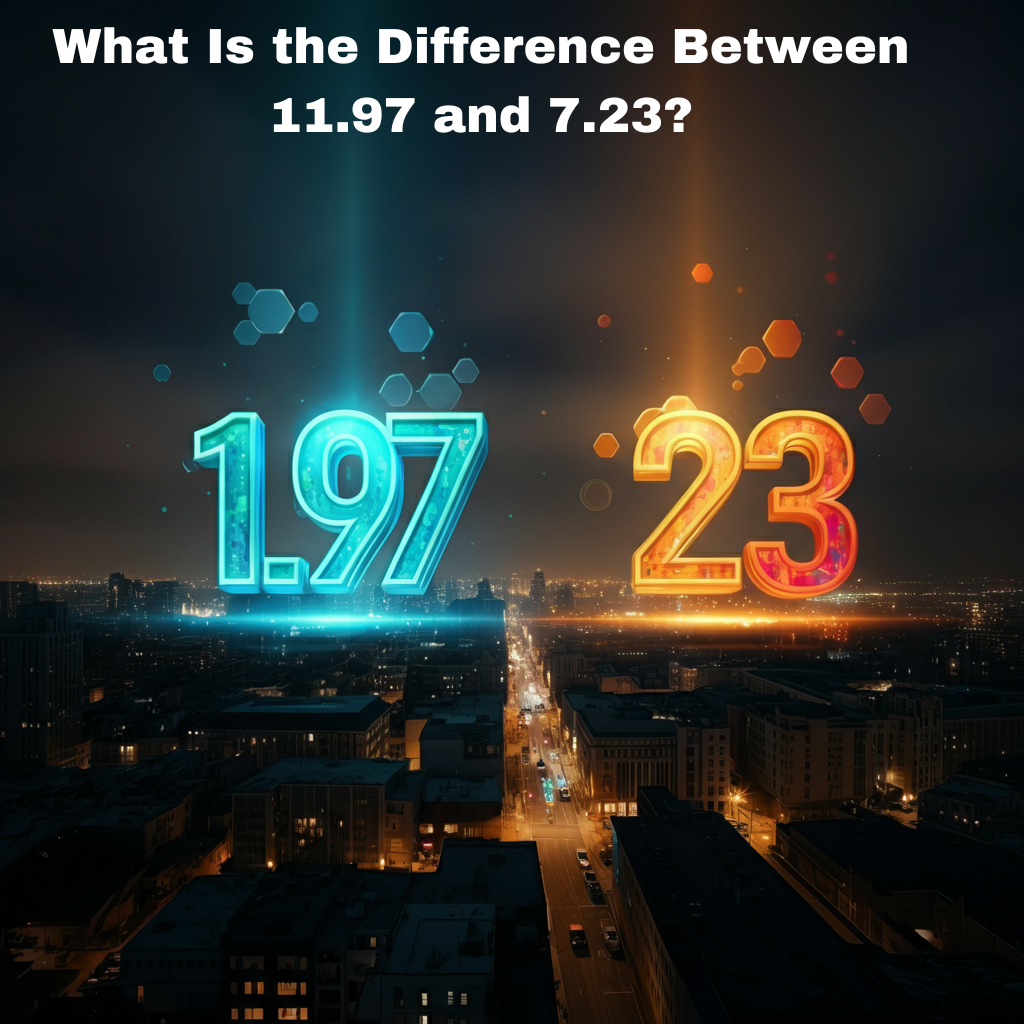Ever come across two numbers and paused to think, “What’s their difference, and why does it matter?” Well, today, we’re tackling just that with 11.97 and 7.23. These may seem like ordinary decimals, but understanding how they differ and why that difference is important—can reveal some fascinating applications in math, finance, science, and even everyday life.
By the end of this post, you’ll not only know that the difference between 11.97 and 7.23 is 4.74 but also understand why those numbers, their comparison, and their applications can have a much bigger significance depending on the context.
Breaking Down the Numbers
Before we jump into their relationship, let’s take a closer look at what 11.97 and 7.23 represent. Both are decimal numbers, meaning they have a whole number component (11 and 7) and a fractional component (.97 and .23). Decimals are everywhere—in measurements, money, statistics, and more.
11.97
- Value: 11.97 is made up of 11 whole units and 0.97 as a fractional value.
- Example Contexts:
- A price tag on designer sunglasses ($11.97 would be a steal, wouldn’t it?).
- Measurement in liters of water in a science experiment (precise and meticulous).
- A GPA score in an alternate, non-traditional grading system where higher numbers matter.
7.23
- Value: Similarly, 7.23 has 7 whole units and a fractional value of 0.23.
- Example Contexts:
- The cost of a morning coffee and croissant combo at your favorite café.
- The average number of hours people spend using their phones daily.
- A temperature reading on a weather forecast for a brisk morning.
Now, while these numbers as standalone figures are important, comparing their difference can unlock new insights.
The Simple Math: What’s the Difference?
From a purely mathematical perspective, the difference between 11.97 and 7.23 is a straightforward subtraction:
11.97 – 7.23 = 4.74
But this isn’t just about plugging numbers into a calculator. It’s about interpreting their difference in context.
Where the 4.74 Difference Actually Matters
1. Finance
Here’s where things get fun (okay, maybe just fun for finance nerds): Imagine you’re managing your monthly budget and notice that you spent $11.97 on one meal but only $7.23 on another. That difference of $4.74 can add up over time, helping you identify areas where you can cut back. Or, flip it around—spending that little extra might mean indulging in something special, like better ingredients or a more memorable dining experience.
Practical Takeaway:
This perspective teaches us the value of analyzing small differences when tracking spending to understand how they align with your priorities.
2. Science
Say you’re conducting a scientific experiment measuring rainfall over two periods of time. If one recorded volume is 11.97 liters and the other is 7.23 liters, the difference of 4.74 liters could indicate significant changes in environmental conditions.
Practical Takeaway:
Even small numerical differences can point to much larger phenomena, like shifts in weather patterns or experimental anomalies.
3. Everyday Life
Ever compared gas prices at two different stations? If one charges $11.97 for a tank of gas and the other $7.23, the $4.74 difference could convince you to take a detour to save money. Similarly, this comparison can play a role when analyzing time spent on daily tasks or calories consumed during meals.
Practical Takeaway:
Learning to recognize and interpret these small differences in daily contexts can lead to smarter decisions.
4. Sports and Fitness
Athletes often compare their times in terms of small numerical differences. Picture a swimmer who completes one lap in 11.97 seconds versus another who achieves it in 7.23 seconds. That 4.74-second difference could mean the gap between first place and an honorable mention.
Practical Takeaway:
Tracking incremental progress in sports and fitness can highlight strengths and pinpoint areas to improve.
5. Marketing and Business Decisions
Imagine analyzing customer reviews for a service where one gets a satisfaction score of 11.97, while the competition gets 7.23. That 4.74-point gap reflects critical differences in customer experience, which businesses can leverage to adapt and improve—whether by rebranding or launching new customer initiatives.
Practical Takeaway:
Numerical differences, when applied, can guide strategic decisions that lead to meaningful business outcomes and growth.
Decoding the Decimal Story
Sure, 11.97 and 7.23 are “just numbers,” but their difference—at 4.74—has a ton of implications in the real world. This highlights an essential point about numbers in general: Context is king. What looks mundane on paper often transforms into something more profound when applied thoughtfully.
To truly grasp these differences:
- Understand what the numbers represent in specific scenarios.
- Take context into account—what do these numbers reveal about the problem, pattern, or challenge?
- Make informed decisions based on the insights gleaned from those differences.
Moving Forward with Numbers
Numbers, no matter how small, shape how we think, act, and make decisions. The 4.74 difference between 11.97 and 7.23 could represent cost, time, measurements, or progress. By learning to interpret these differences, you can unlock smarter, data-driven outcomes in both your personal and professional life.
Got a set of numbers you’re curious about? Drop them in the comments, and let’s break them down together. Don’t forget—every digit tells a story.


